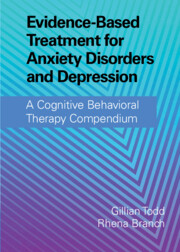 Evidence-Based Treatment for Anxiety Disorders and Depression
Evidence-Based Treatment for Anxiety Disorders and Depression from Part One - Cognitive Behavioral Therapy for Anxiety Disorders
Published online by Cambridge University Press: 06 January 2022
Clark and Wells advanced a cognitive model of social anxiety disorder (SAD) that has received substantial empirical support. The model accounts for the persistence of SAD with reference to a set of specific cognitive behavioral mechanisms involving feedback cycles that are responsible for maintaining the problem. Cognitive behavioral therapy (CBT) derived from this model aims to address these mechanisms, which include, among others, maladaptive self-processing and styles of coping consisting of safety behaviors and anticipatory and post-event processing. The treatment is recognized as the treatment of choice in clinical guidelines. We present the Clark and Wells’s model of SAD in detail and describe how SAD can be treated with CBT. Furthermore, we address topics such as clinical management and assessment, research supporting CBT for SAD, and further developments based on the metacognitive model.
To save this book to your Kindle, first ensure [email protected] is added to your Approved Personal Document E-mail List under your Personal Document Settings on the Manage Your Content and Devices page of your Amazon account. Then enter the ‘name’ part of your Kindle email address below. Find out more about saving to your Kindle.
Note you can select to save to either the @free.kindle.com or @kindle.com variations. ‘@free.kindle.com’ emails are free but can only be saved to your device when it is connected to wi-fi. ‘@kindle.com’ emails can be delivered even when you are not connected to wi-fi, but note that service fees apply.
Find out more about the Kindle Personal Document Service.
To save content items to your account, please confirm that you agree to abide by our usage policies. If this is the first time you use this feature, you will be asked to authorise Cambridge Core to connect with your account. Find out more about saving content to Dropbox.
To save content items to your account, please confirm that you agree to abide by our usage policies. If this is the first time you use this feature, you will be asked to authorise Cambridge Core to connect with your account. Find out more about saving content to Google Drive.